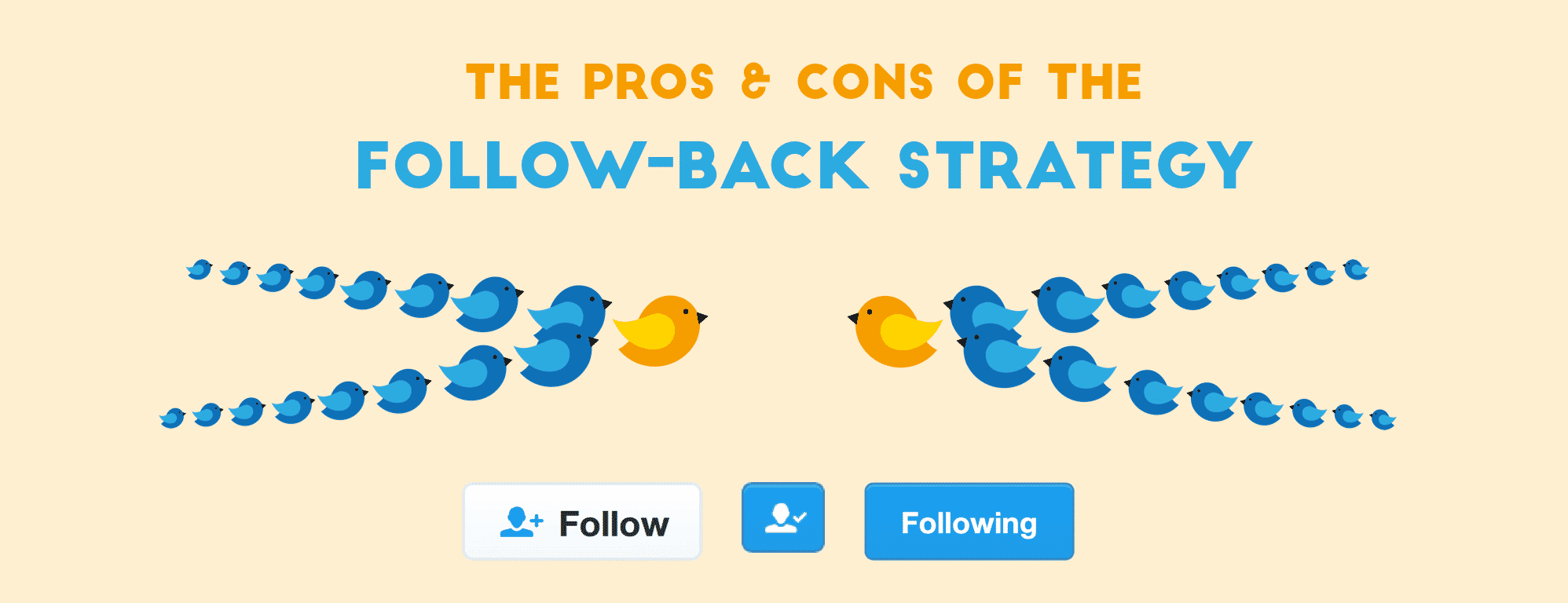The follow-back strategy is an aggressive marketing technique used by Twitter users, to rapidly increase their following and boost their credibility online.
The basic idea is to follow a person on Twitter – usually a popular person, who has a network you want to be in on – in the hopes that they will follow you back.
There’s a debate over how useful it is in today’s world of constant advertising and notifications, but it’s still seen by many as a fairly effective strategy on the whole.
Some experts say that following people back dilutes one’s feed, and devalues the essential concept of Twitter, which is to naturally connect with people in the same interest group.
Others, however, say that following a wide variety of people actually contributes to the whole microblogging experience, making for a more diverse and interesting experience for everyone.
What’s the truth?
The truth is that there are some good things and some bad things about the follow-back strategy.
Depending on what you are looking for on the platform, following back can either offer some advantages or set you back. If you want to make an informed decision about this topic, saddle up because we listed some of the biggest pros and cons of the follow-back strategy on Twitter.
Let’s Start with the Pros
Sure fire way to increase your following
As mentioned earlier, the follow-back strategy is one of the oldest tricks in the book when it comes to increasing your followers. Twitter users are fond of returning the favor and oftentimes follow back those who follow them – even if they don’t know the other user.
The rule of reciprocity is the very reason why this technique works!

This can also help you establish some sort of ground with influencers who have a much larger following than you. Following them can increase your chances of being followed back – as long as you make a conscious, sincere effort to connect.
The more you follow, the more you are followed
Following people creates a ripple effect that can result in rapidly increasing the size of your following in a short amount of time. Once you amass more followers from your efforts, Twitter’s algo will pick up on it and may suggest you to users under the same interest group.
Users take Twitter suggestions seriously and if they see that you are being followed by someone they know, they won’t think twice about hitting the follow button.
You get to know more people
Did you know the Uber founders Travis Kalanick and Ryan Graves met each other off Twitter? We might not be enjoying the ride sharing app if it wasn’t for one little tweet.

If you’re looking into building the next app that will change the world or if you are simply looking to expand your connections within your industry, following people can be a great first move.
By making a conscious effort to follow other users, you put yourself in a position where you can begin building relationships. You should like and comment on their tweets, and don’t be afraid to engage in a conversation with them.
Now Let’s Talk About the Cons
You might get too much on your plate (or feed)
Following people in the hopes of getting a follow back can dilute your feed with all the updates you’ll see from them. If you are the type who easily gets overwhelmed with a surge of probably-irrelevant updates, then aggressively following people may not be for you.
You can opt to create a list, but that takes a lot of work. If you’re not willing to go through the trouble, you’ll have to be careful about not following too many people.
You’ll look like a phony based on your follower/following ratio
Users can get hints from your follower/following ratio that might suggest you’re trying to manually manipulate your popularity on Twitter. Check out how many users this account is following, compared to their followers:

If you’re following a lot of people but have a low number of followers in return, you risk being called a phony as this usually raises red flags among fellow tweeters.
This is especially bad for a business, as it would seem like you are influencing the consumer’s perception of your service/brand/product.
If you are a business, we suggest you steer clear from this technique and opt for more organic means of increasing your following. This way, nobody can call you out for being a big fat phony.
You’ll end up with a bunch of fake followers
The followers you gain using this method are often fake, and will generate little to no engagement.
If you do end up getting authentic followers, it’s unlikely they will ever turn into customers because they usually won’t be remotely interested in you or your business – they’re just in it for the follow back.
Check out this fake follower, who won’t look too good attached to your account:

Staying relevant and engaging can be difficult
Following a whole bunch of people without any sort of targeting can make engagement a difficult effort on your part.
If done aggressively, this technique can drive you to follow random people just because you have a better chance of getting a follow back from them. This can distract you from reaching out to the people you actually should be getting in touch with.
You will also have a hard time engaging with them. If you do not know much about the people you follow, striking up a conversation or retweeting their comments (and actually providing some value) can be awkward and difficult.
You’ll reach your follow limit
Aggressively following people is a fast way to reach your follow limit.
To prevent abuse of the platform, a regular Twitter account can only follow a maximum of 5,000 followers. If you’re blindly following everyone you can, 5,000 followers isn’t a lot.
Twitter does make exceptions for verified accounts and those with impressive following/follower ratios, but the numbers for these exceptions are not published anywhere.
If you do not have a verified account, we suggest you carefully choose who you follow. Being selective doesn’t necessarily mean turning your back on this technique entirely, it just means you are choosing the people you associate yourself with wisely.
You can still get a follow back despite being selective – the only difference is you are getting them from users who are actually relevant to your niche.
Choose Who You Follow
The follow back technique is an effective way to gain new followers speedily but you have to go at it with a plan in mind.
Following users for the sake of getting a follow back is like throwing punches in the dark – you might get a few punches in there but for the most part you’ll just be wasting your energy.
If you want to increase your following while maintaining a level of relevance and engagement, using Twitter Ads may be the most viable option – but it’s gonna cost ya. Signing up for Twitter ads can get you authentic and highly engaging followers that are targeted to your specific niche.
If you just want to increase your followers in record time without maxing out your follow limit, then you might want to consider purchasing high quality followers instead. This boosts your numbers without diluting your feed with unimportant and irrelevant updates from people you barely know.
There are a number of providers out there who offer different kinds of followers at different price ranges. You’re sure to find one that can contribute to your campaign’s success.
Before buying followers, do your research. Reading reviews from sites like ours can help you choose the best provider for your budget and needs.
We hope this guide will help you strategize your next big move on Twitter. Now go get ‘em!



